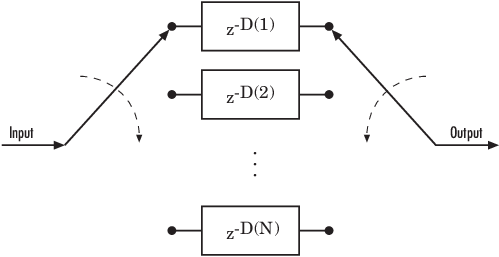comm.gpu.ConvolutionalDeinterleaver
Deinterleave symbols using set of shift registers with GPU
To use this object, you must install Parallel Computing Toolbox™ and have access to a supported GPU. If the host computer has a GPU configured, processing uses the GPU. Otherwise, processing uses the CPU. For more information about GPUs, see GPU Computing (Parallel Computing Toolbox).
Description
The comm.gpu.ConvolutionalDeinterleaver
System object™ deinterleaves the symbols in the input sequence with a graphics processing unit
(GPU).
To deinterleave the symbols in the input sequence with GPU:
Create the
comm.gpu.ConvolutionalDeinterleaverobject and set its properties.Call the object with arguments, as if it were a function.
To learn more about how System objects work, see What Are System Objects?
Creation
Syntax
Description
deintrlvr = comm.gpu.ConvolutionalDeinterleaver
deintrlvr = comm.gpu.ConvolutionalDeinterleaver(Name=Value)NumRegisters=10 specifies the number of internal shift
registers.
intrlvr = comm.gpu.ConvolutionalDeinterleaver(m,b,ic)NumRegisters
property to m, the RegisterLengthStep property to b, and the InitialConditions property to ic.
Properties
Usage
Description
deintrlvseq = deintrlvr(intrlvseq)inputseq by using a set
of shift registers. The output is the deinterleaved sequence.
For information about delays, see Delays of Convolutional Interleaving and Deinterleaving.
Input Arguments
Output Arguments
Object Functions
To use an object function, specify the
System object as the first input argument. For
example, to release system resources of a System object named obj, use
this syntax:
release(obj)
Examples
More About
Extended Capabilities
Version History
Introduced in R2012a
See Also
Objects
comm.gpu.ConvolutionalInterleaver|comm.ConvolutionalDeinterleaver|comm.ConvolutionalInterleaver|gpuArray(Parallel Computing Toolbox)
Functions
Blocks
Topics
- Interleaving
- GPU Arrays Support List for System Objects
- GPU Computing (Parallel Computing Toolbox)
- Accelerate Simulation Using GPUs
